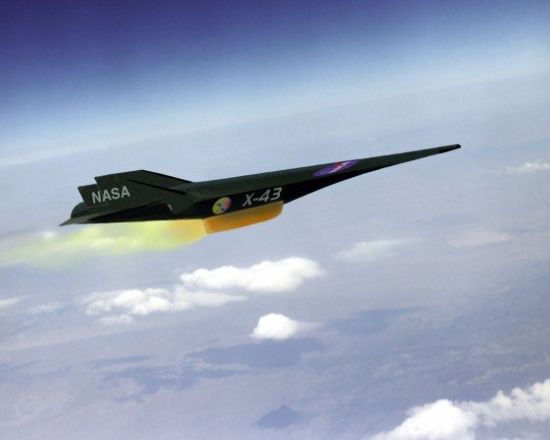
Hydrogen and the ScramJet
In order to make a scramjet work, researchers must choose a fuel that can burn rapidly and generate a large amount of thrust. Hydrogen meets these criteria.
One way to illustrate the differences between various fuels and their energy content is a measurement called the Lower Heating Value (LHV). The LHV describes the amount of energy released when a fuel is combusted and all of the remaining combustion products remain in gaseous form. The LHV for hydrogen is 119,600 kJ/kg. JP-8, another fuel commonly used in military aircraft, has a LHV of only 43,190 kJ/kg, less than half that of hydrogen. Simply put, hydrogen provides more "bang" per kilogram than JP-8, or any other hydrocarbon fuel for that matter.
There are also other advantages to using hydrogen as a fuel. First of all, hydrogen is extremely flammable; it only takes a small amount of energy to ignite it and make it burn. Hydrogen also has a wide flammability range, meaning that it can burn when it occupies anywhere from 4% to 74% of the air by volume. Since hydrogen is a gas, it mixes very easily with air allowing for very efficient combustion. Another advantage over hydrocarbon-based fuels like JP-8 or gasoline is that hydrogen does not produce any harmful pollutants like carbon monoxide (CO), carbon dioxide (CO2), or particulate matter during the combustion process. It is for this reason alone that many researchers have promoted hydrogen as a fuel in the public transportation industry.
Nevertheless, there are some disadvantages to using hydrogen as a fuel in aerospace vehicles. Hydrogen is not a dense fuel. At standard pressure and temperature, it has a density of only 0.09 kg/m3. Compare that to the density of gasoline at 750 kg/m3 or JP-8 at 800 kg/m3. While this low density is an advantage in terms of saving weight, hydrogen requires a large volume in order to store an adequate amount of chemical energy for practical use. Hydrogen gas is typically stored under pressure to increase its density, but even at 10,000 psi (68,950 kPa) it will contain only a quarter of the chemical energy stored in an equivalent volume of JP-8. The density of hydrogen can be further increased by cooling and pressurizing the substance to the point that it becomes a liquid, but even in this form it will need a tank approximately twice the size of that required by JP-8. In addition, the cost and safety issues involved in manufacturing and storing cryogenically-cooled fuel is another major drawback. Despite the clear advantages of hydrogen described earlier, more energy can often be stored in smaller volumes using denser fuels. As a result, vehicles burning denser hydrocarbon fuels can usually fly longer distances than those using hydrogen.
Even given these limitations, however, hydrogen has been a clear choice for many scramjet researchers due to its versatility and performance. One of the first hydrogen-fueled scramjets ever flown was the X-43A launched on 27 March 2004. The X-43A is part of NASA's Hyper-X program to develop new air-breathing propulsion systems for use in hypersonic flight. To date, this vehicle is the only official airframe-integrated scramjet to fly autonomously under its own power. A milestone in scramjet research, the X-43A achieved positive acceleration while climbing at Mach 7 for approximately 10 seconds. A Mach 10 version of the X-43A is currently slated to fly by the end of 2004.
Excerpted from: http://www.aerospaceweb.org/question/propulsion/q0170.shtml